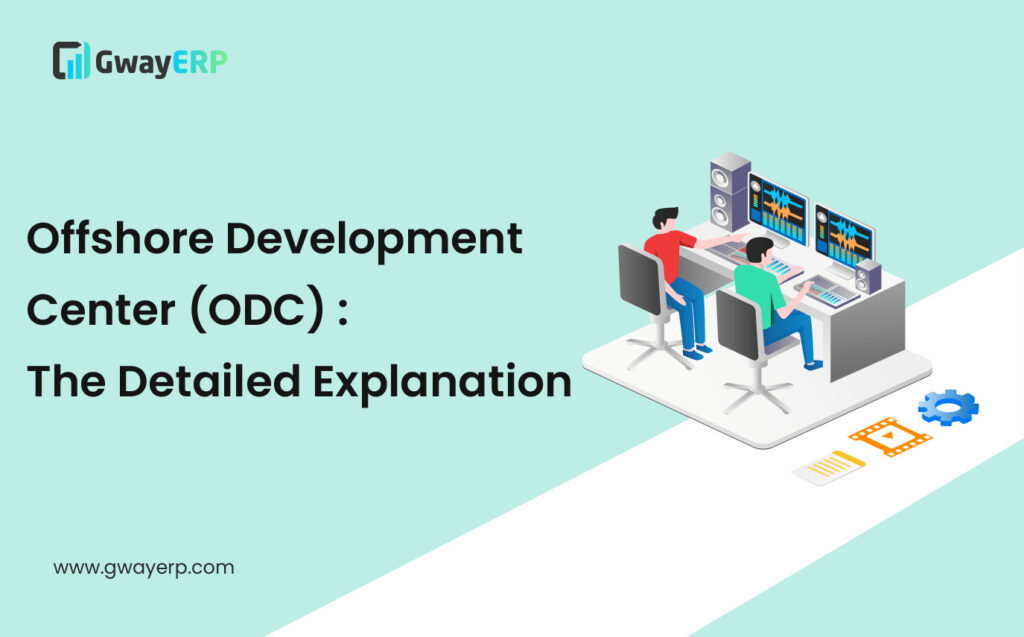
I. Introduction to offshore development centers
• Businesses use offshore development centers (ODCs) as a strategic tool to access people and resources around the world for IT-related tasks like software development.
• These facilities, which are usually found in nations with cheaper labor costs, give businesses the chance to cut costs without sacrificing output quality. Through comprehension of the complexities surrounding offshore development centers, companies can gain substantial benefits in the current competitive industry.
A. Understanding offshore development centers
• Organizations create offshore development centers (ODCs) as specialized units to manage software development and related tasks remotely.
• Comprehending the function and importance of overseas development companies is imperative for enterprises looking to enhance their efficiency and efficiently access worldwide workforces.
1. Definition and overview
• Companies set up offshore development centers (ODCs) as specialized facilities to assign software development work to faraway areas. They provide a broad range of services, including as testing, maintenance, and coding, and they give enterprises access to reasonably priced resources and knowledge.
• ODCs have evolved from being merely cost-cutting tools to being strategic assets that foster cooperation and innovation.
2. Meaning of offshore development centers (ODCs)
• Dedicated departments set up by businesses to manage software development work remotely are known as offshore development centers through the use of offshore resources, these centers enable businesses to save operating costs and get access to worldwide talent pools.
• ODCs are essential to a company’s ability to grow and maintain its competitiveness in the fast-paced business environment of today.

3. Evolution of offshore development centers
• The way offshore development centers, or ODCs, have developed has mirrored the shifting nature of the world’s commercial environment. Since being seen as a way to cut costs, open-ended contracts (ODCs) have become strategic tools that promote cooperation and innovation.
• ODCs have evolved from basic outsourcing hubs to intricate centers of excellence, and they are now essential to the success of contemporary companies.
B. Importance in global business
• Offshore Development Centers (ODCs) play a vital role in the global business landscape for various reasons. Firstly, they offer significant cost savings by utilizing lower labor costs in offshore locations. Secondly, ODCs provide access to a diverse talent pool, empowering companies to tackle complex projects and drive innovation effectively.
• Thirdly, their 24/7 operations ensure uninterrupted service delivery and client support worldwide. Additionally, ODCs provide scalability, allowing businesses to adapt their resources and infrastructure as per project needs. By outsourcing non-core tasks, companies can focus on their primary strengths and strategic goals.
1. Role of ODCs in Outsourcing
• Offshore development centers (ODCs) are essential for it outsourcing since they let businesses assign software development work to distant places. Organizations can acquire specialized knowledge and skills while cutting expenses by utilizing ODCs.
• In the it industry, ODCs are essential for shortening project durations, improving adaptability, and spurring innovation.
2. Economic impact of offshore development centers
• Beyond just cutting costs, offshore development centers (ODCs) have a broad range of positive effects on economies and businesses. By generating jobs, encouraging innovation, and drawing in foreign investment, offshore development corporations (ODCs) boost economic activity in offshore areas.
In today’s international economy, they also support sustainable growth and development by fostering the transfer of knowledge and the development of skills.
II. Setting up an offshore development center
The creation of an offshore development center, or ODC, is a calculated strategic decision that can significantly affect a business’s operations and future course. By utilizing offshore resources and labor, businesses can increase their competitiveness and accelerate innovation.
A. Key considerations for establishing an ODC
To ensure success, the establishment of an offshore development center (ODC) entails a number of important factors that need to be properly considered. Every element, from choosing the ideal site to organizing the ODC staff, is critical to the center’s efficacy and efficiency.
a. Location selection for your offshore development center (ODC)
Your offshore development center’s (ODC) long-term success depends on where you choose to put it. To make an informed choice, factors including infrastructure, talent availability, cost-effectiveness, and time zone compatibility should be carefully considered.
1. Factors to consider when choosing an ODC location
• A number of considerations need to be made while assessing possible sites for an offshore development center (ODC). These include the business climate, legislative requirements, cultural affinities, linguistic competency, and geopolitical stability.
• Further factors that may impact the choice of location include accessibility to specialized expertise and closeness to important markets.
2. Popular ODC destinations and their advantages
• Several countries have emerged as popular destinations for establishing offshore development centers (ODCs), each offering unique advantages and incentives.
• Locations such as India, Ukraine, and the Philippines are renowned for their large talent pools, cost-effectiveness, and favorable business environments. These destinations provide businesses with access to skilled professionals, robust infrastructure, and cultural compatibility, making them ideal choices for setting up ODCs.

b. Structuring your ODC team
A committed workforce must be assembled and led if an offshore development center (ODC) is to succeed. To maximize output and promote cooperation, the team must be arranged efficiently and best practices for remote team management must be put into place.
1. Building a dedicated team for your ODC
Building a committed staff takes careful planning and hiring. Building a high-performing team that matches your company objectives requires knowing the precise skill sets and knowledge required for your projects and working with hr specialists to find outstanding workers.
2. Best practices for managing remote teams in ODCs
Offshore development centers (ODCs) must use technology tools and best practices to manage remote teams efficiently. The key to effectively managing remote teams and optimizing their performance is to create a culture of trust and collaboration, use project management software, establish clear communication routes, and offer regular feedback and assistance.
III. Advantages of offshore development centers
Businesses may streamline operations, cut expenses, and gain access to a varied talent pool with the help of offshore development centers (ODCs), which provide numerous advantages. For businesses looking to obtain a competitive edge in the current global marketplace, understanding these benefits is essential
A. Benefits of partnering with an ODC
There are several benefits to partnering with an offshore development center (ODC), from scalability and cost savings to talent and specialized knowledge. These advantages provide companies the ability to improve productivity, spur innovation, and experience long-term success.

a. Cost savings and scalability
• Among the main benefits of working with an offshore development center (ODC) are cost savings and scalability.
• Businesses can save a lot of money on operating costs by outsourcing development jobs to offshore sites, and they can still grow their projects to meet changing business needs.
1. Cost reduction strategies through offshore development centers (ODCs)
• The offshore development centers (ODCs) provide a range of cost-cutting tactics, such as decreased labor costs, fewer overhead expenditures, and affordable access to specialized knowledge.
• Businesses can save a considerable amount of money by using these tactics to deploy resources more effectively and optimize their development budgets.
2. Scalability options for offshore development center (ODC)-based projects
• Businesses can scale project execution with the help of offshore development centers (ODCs), which allow them to add or remove resources as needed without incurring large overhead costs.
• This adaptability enables businesses to quickly adjust to shifting market demands, expedite project schedules, and efficiently utilize their resources.
b. Access to diverse talent pool
• An offshore development center (ODC) partnership offers access to a varied talent pool, which is an additional advantage.
• Businesses can construct specialized teams that are tailored to their project requirements by using ODCs to connect with a worldwide network of talented experts with a variety of cultural backgrounds and areas of expertise.
1. Leveraging global talent for specialized skills in offshore development centers (ODCs)
• With their specialized skills and subject experience, offshore development centers (ODCs) provide access to a large global talent pool.
• Businesses can take on challenging tasks, foster creativity across a range of industries, and improve the caliber and effectiveness of their development projects by utilizing this talent.
2. Strategies for recruiting and retaining top talent in offshore development centers (ODCs)
• Offshore development centers (ODCs) must successfully attract and retain outstanding talent. To attract and retain qualified individuals in ODCs, businesses can use a variety of techniques, including competitive remuneration packages, chances for professional growth and development, attractive work environments, and work-life balance initiatives.
• These tactics assist companies in creating high-achieving teams and preserving their competitive advantage in the worldwide market.
IV. Challenges and solutions in offshore development
There are a number of obstacles to overcome when navigating the offshore development center (ODC) environment. However, companies may get over these obstacles and optimize the advantages of working remotely by implementing proactive strategies and practical solutions.
A. Overcoming common challenges in ODC operations
Offshore development centers (ODCs) frequently deal with similar issues that might reduce output and affect the results of projects. Businesses can guarantee seamless operations and attain the intended outcomes from their offshore endeavors by recognizing these obstacles and putting focused solutions in place.
a. Communication and cultural differences
• Successful collaboration in offshore development centers (ODCs) requires effective communication and a grasp of cultural differences.
• It takes specialized tactics to establish open communication and encourage cultural awareness in order to overcome communication obstacles and resolve cultural differences.
1. Effective communication strategies in ODCs
• In ODCs, establishing and executing efficient communication plans is essential to closing the distance between onshore and offshore personnel.
• To improve cooperation and guarantee agreement on project goals and objectives, regular meetings, the use of communication tools, and the promotion of an open communication culture are all recommended.
2. Addressing cultural barriers in ODC collaboration
• Collaboration and productivity in offshore development centers (ODCs) can be impacted by cultural differences.
• In order to overcome cultural obstacles, one must raise understanding of other cultures, offer cross-cultural training, and create a welcoming workplace that values diversity and promotes candid communication.

b. Ensuring data security and compliance
• When operating an offshore development center (ODC), data security and compliance are essential factors to take into account. Protecting confidential data and upholding legal compliance in offshore partnerships require putting strong security measures in place and following regulations.
• Tual property is paramount in offshore development center (ODC) operations. Implementing robust security measures, such as encryption protocols, access controls, and regular security audits, helps mitigate security risks and ensures the confidentiality and integrity of data in offshore projects.
1. Compliance requirements and regulations for ODCs
• Ensuring regulatory compliance is crucial to reducing legal risks and preserving public confidence in offshore development centers (ODCs).
• Companies need to make sure that offshore collaborations comply with data protection and privacy rules by putting in place procedures to assure compliance and staying updated about pertinent standards like GDPR, HIPAA, and PCI-DSS.
V. Emerging trends shaping the future of ODCs
The offshore cooperation landscape is changing as offshore development centers (ODCs) take on new forms. Businesses looking to stay ahead of the curve and utilize odcs to their fullest extent in their operations must comprehend these tendencies.
a. Adoption of advanced technologies in ODCs
The adoption of advanced technologies is revolutionizing the way odcs operate, enhancing efficiency, and driving innovation. Embracing these technologies enables odcs to streamline processes, improve productivity, and deliver higher-quality solutions to clients.
1. Role of ai and machine learning in ODC processes
• ODC operations are progressively incorporating AI and machine learning, which presents chances for automation, predictive analytics, and wise decision-making.
• ODCs may reduce risks, maximize resource allocation, and provide clients with individualized experiences by utilizing AI-driven solutions.
2. Exploring opportunities with blockchain and IoT in ODC projects
• Technologies like blockchain and IoT have enormous potential to spur innovation in ODC initiatives.
• Leveraging these technologies creates new opportunities for value creation and distinction in offshore collaborations, from improving data security and transparency to providing real-time data insights and process automation.
b. Evolution of remote work culture and hybrid models
• The way ODC teams collaborate and work is changing as a result of the development of the remote work culture and the emergence of hybrid models.
• Businesses can capitalize on remote work’s advantages while preserving the benefits of traditional office settings by adopting these modifications.
1. Remote work strategies for ODC teams
• To guarantee productivity and teamwork within ODC teams, it is imperative to put into practice efficient remote work solutions.
• The secret to success in remote work environments is to give remote workers the resources they need, prioritize work-life balance, and maintain open lines of communication.
2. Hybrid offshore development center models for flexibility and efficiency
• Hybrid ODC architectures offer flexibility, scalability, and cost-effectiveness by combining the advantages of on-site and offshore resources.
• Through the strategic integration of both on-site and remote resources, organizations may enhance project delivery, reduce risks, and efficiently adjust to evolving market conditions.
VI. Your complete manual/checklist for operating an ODC
To ensure success, an offshore development center (ODC) must be operated with meticulous planning, efficient management, and ongoing optimization. Here is a thorough manual and check list to assist you in navigating the challenges of properly operating an odc:
1. Track performance and quality:
To keep tabs on ODC performance and project quality, set up key performance indicators (KPIs). Review performance on a regular basis and make adjustments as needed.
2. Encourage morale and team engagement:
By providing opportunities for professional progression, team-building exercises, and recognition programs, you may cultivate a good work atmosphere and increase team engagement.
3. Continuous improvement:
To increase ODC effectiveness and efficiency, adopt a culture of continuous improvement by asking team members for input, identifying areas for optimization, and putting best practices into action.
4. Analyze the ODC’s performance:
Assess your ODC’s performance on a regular basis in relation to predetermined goals and KPIs. Utilize the knowledge you’ve obtained to guide initiatives for continuous development and make wise judgments.
VII. The best places to get your ODCs
The location of your offshore development center (ODCs) will determine how successful it is. Many factors, including talent availability, cost-effectiveness, infrastructure, and geopolitical stability, play a role in the selection of odc locations.

A. Some popular locations for ODC establishments are as follows:
1. India: India continues to be a major offshore development location due to its existing infrastructure, competitive labor prices, and large pool of highly skilled workers.
2. Eastern Europe: nations like Romania, Poland, and Ukraine appeal to ODCs because they combine cost benefits, cultural affinities with western Europe, and technical know-how.
3. Philippines: The country is becoming more and more of a desired location for ODCs, especially in the business process outsourcing (BPO) sector, thanks to its robust English-speaking workforce and expanding industry.
4. Vietnam: particularly in Southeast Asia, Vietnam is becoming a more and more preferred option for overseas direct companies (ODCs) because of its fast growing sector, youthful and tech-savvy workforce, and affordable labor prices.
5. Latin America: Nearshore ODCs find countries like Mexico, Brazil, and Argentina appealing due to their close proximity to North American markets, cultural affinities, and expanding talent pools.
FAQ’s
1. What is an offshore development center (ODC)?
An ODC is a remote facility established by companies to handle software development or IT services in a cost-effective manner.
2. Why do companies set up offshore development centers (ODCs)?
Companies set up ODCs to access global talent, reduce costs, and expand development capacity efficiently.
3. Why choose GwayERP’s Associated Development Center?
GwayERP’s Associated Development Center benefits include shared resources and expertise, reduced development costs, accelerated time-to-market, access to new markets or technologies, and increased innovation through collaboration.
4. How do companies select partners for Associated Development Centers?
Partner selection involves evaluating compatibility in terms of goals, expertise, culture, and resources, as well as conducting due diligence on reputation, capabilities, and track record.
5. Do software companies usually have offshore development centers?
Yes, it’s quite common for software companies to have offshore development centers (ODCs). They utilize ODCs to access global talent, reduce costs, and expand their development capacity efficiently, allowing them to focus on core business activities while outsourcing non-core functions to remote locations.

